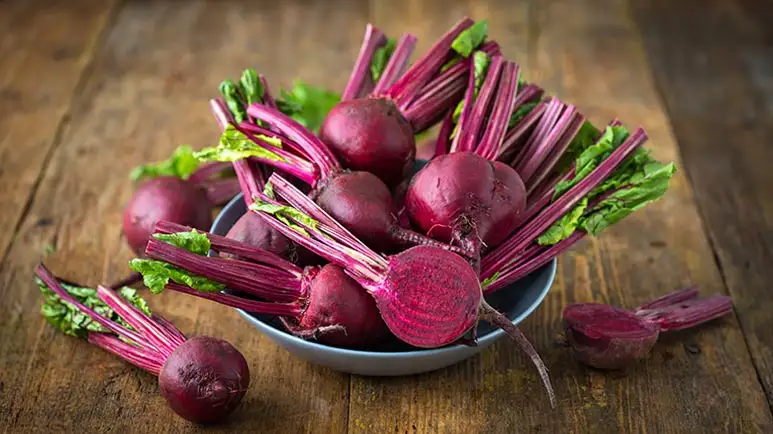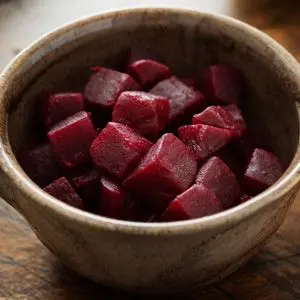Beets: This Colorful Root Crop Provides Your Pet with Antioxidants
According to animal studies, the brilliant pigments in this food offer neuroprotective and anti-inflammatory effects. What’s the best way to add it to your pet’s meals? Read here to find out.

STORY AT-A-GLANCE
- Beets are considered one of the richest sources of betanins, which exhibit antioxidant defense mechanisms and gene-regulatory activity
- Beets contain carotenoids and phenolic compounds that exert antioxidant, anti-inflammatory and anticarcinogenic properties
- When selecting beets, look for those with bright green leaves, deep maroon coloring and unblemished skin
- All treats and food toppers, including healthy add-ins like beets, should only make up 10% of your pet’s daily caloric intake
Editor's Note: This article is a reprint. It was originally published July 14, 2022.
Often used in soups, salads and detox juices, beets (Beta vulgaris) are root vegetables known for their vibrant red (and sometimes yellow) color, as well as their earthy flavor. Also called beetroot, table beets or garden beets, these root crops are versatile, inexpensive and widely available all year round — but can they be added to pets’ diets, too? Continue reading to find out and learn the role beets play in the pet food industry.
Different Beets, Different Colors

When people think of beets, the variant that likely comes to mind are red beets, as they’re the most common. But aside from the familiar reds, there are also golden beets, which taste more mellow, and Chioggia beets, which are naturally striped red and cream or yellow and orange.1
Beets also come in a white variety — these are called sugar beets, a common fiber source in processed pet food (more about this later).
Betalains: Brilliant Pigments with Antioxidant Potential
Betalains are nitrogen-containing, water-soluble plant pigments that come in two forms: the red-violet betacyanins and the yellow-orange betaxanthins, both of which are found in beets. The redness of beets depends on the ratio between these two phytochemicals. But aside from providing a vibrant hue, these compounds also contribute to beets’ health benefits.2
Beets are considered one of the richest sources of betanin, a type of betacyanin. According to Molecular Nutrition and Food Research,3 betanins exhibit antioxidant defense mechanisms and gene-regulatory activity. They may also help inhibit DNA damage and LDL cholesterol oxidation, which is a marker of heart disease.
In a study published in the journal Metabolic Brain Disease,4 the neuroprotective effects of betanins were evaluated on mice with Parkinson-like motor dysfunction and neurodegeneration. Results showed that betanins exhibit neuroprotective effects by increasing the levels of glutathione, a powerful antioxidant, and inhibiting the increase of malondialdehyde, which in turn lowers the production of free radicals.
Beets Offer Powerful Carotenoids and Phenolic Compounds
“Carotenoids present in beetroot, such as lutein and beta-carotene,5 act as antioxidant, anticarcinogens and immuno-enhancers.6”
Studies published in Veterinary Immunology and Immunopathology confirmed that lutein supports the cell-mediated and humoral responses in both cats and dogs.7,8 Beta-carotene, on the other hand, may help reduce the risk for cardiovascular disease, obesity and other chronic health conditions.9 Research also suggests that it may be beneficial for cats with renal insufficiency, as it helps reduce DNA damage.10
Moreover, beets contain high amounts of phenolic compounds that exert antioxidant, anti-inflammatory and anticarcinogenic properties, including epicatechins, caffeic acid, catechin hydrate and hydroxybenzoic acid.11 According to a study in Critical Reviews in Food Science and Nutrition, these phenolics, along with betalains, may have positive effects on gut microbiota and overall gastrointestinal health.12
Beets Help Increase Levels of Heart-Protective Nitric Oxide
Beets are one of the richest sources of dietary nitrates (more than 250 milligrams per 100 grams of fresh weight13), which are converted in the body into nitric oxide, a compound that acts as a “strong vasodilatory and anti-inflammatory signaling molecule,” helping promote proper endothelial function, which in turn reduces your pet’s risk of high blood pressure and cardiovascular disease.14
According to a study published in the Indian Journal of Medical Research, nitric oxide is also responsible for supporting proper blood supply to the brain. Hence, it’s important for various neuronal functions, such as those involved in learning and memory processes, food intake and immune response, among others. In fact, low nitric oxide levels have been linked to cognitive deficits in rats, chicks and fish.15
Another study published in Research in Veterinary Science found that the inhibition of nitric oxide synthesis in cats resulted in higher arterial pressure and increased renal vascular resistance,16 which could lead to kidney damage and eventually renal failure.17 This highlights the importance of nitric oxide in feline renal hemodynamics.18
Beets Are Home to Various Health-Boosting Vitamins
According to an article published in the Journal of Nutritional Medicine and Diet Care, beets are rich in vitamins C, E and K.19 One cup of beets contains 6.66 milligrams (mg) of vitamin C,20 a powerful antioxidant that’s essential for the growth and repair of tissues,21 and 0.054 mg of vitamin E,22 which also helps inhibit oxidative stress and supports proper immune function.23 Meanwhile, vitamin K is present at 0.272 micrograms per one cup of beets. This vitamin plays a role in blood clotting.24
Beets also contain B vitamins, including vitamin B1 (thiamine), B2 (riboflavin), B3 (niacin), B4 (pantothenic acid), B6 (pyridoxine), B9 (folate) and B12 (cobalamin). B vitamins play interrelated roles to support your pet’s cellular function, from converting food into energy to supporting proper immune response.25,26,27
Beets Provide Both Soluble and Insoluble Fiber
Beets are rich in both soluble and insoluble fiber, providing a total of 0.24 grams for every 1-tablespoon serving. Soluble fiber disperses in water and binds with fatty acids, helping slow down digestion and reduce blood sugar levels. Insoluble fiber, on the other hand, provides roughage and bulks up the stool, which helps promote regular bowel movements.
Keep in mind, however, that healthy cats and dogs don’t need an excessive amount of fiber, so make sure to limit the serving of beets you give your pet if you decide to add this food to their diet. All treats and food toppers, including healthy add-ins like beets, should only make up 10% of your pet’s daily caloric intake.
Can Beets Really Solve Hairball Problems?

An article published in Mental Floss28 suggested feeding beets to cats to make them poop out hairballs instead of coughing them up. However, this is an ill-advised recommendation.
In fact, the study they referenced in the article said that adding beets to cats’ diets didn’t reduce the amount or size of the hairballs they produced29 — it only made them poop more because they consumed more fiber. Remember: If your cat is producing a lot of hairballs, what they need is a veterinary exam.
The Role of Beets in the Processed Pet Food Industry
As mentioned above, white beets, or sugar beets, are commonly found in processed pet food. To be exact, it’s beet pulp that manufacturers use, a byproduct of sugar beet processing and one of the most widely used plant fibers in kibble and canned foods, along with peanut and other grain hulls and even feather meal.
Moreover, almost all of the sugar beets produced in the U.S. have been genetically modified, which is something you don’t want in your family’s diet, including your pets. Feeding your animal companion processed pet food that contains beet pulp not only exposes them to a genetically modified ingredient that’s potentially laden with toxic chemicals, but it also adds too much filler to their diet, including excessive fiber, which can impair the absorption of critical nutrients, predisposing pets to deficiencies.
How to Choose Safe and Sustainably Grown Beets for Pets
If you’ve set your heart on giving beets to your pet, stick to the usual red or yellow table beets. According to the Canadian Biotechnology Action Network, there are currently no genetically modified table beets on the market. This means that, unlike sugar beets that have been genetically engineered to tolerate glyphosate, table beets are less likely to be sprayed with this herbicide and are therefore safer for your pet and more sustainable for the environment.30
To make sure that the table beets your family eats are truly spray-free, check your local farmers market and buy from trustworthy sources that utilize sustainable farming practices, like crop rotation and mixed cropping. When selecting beets, look for those with bright green leaves, deep maroon coloring and unblemished skin.31
Which Country Produces the Most Beets?

The Netherlands ranked first in the global beetroot market, followed by Italy and China.32 In the U.S., Wisconsin, Oregon and New York produce the highest amount of table beets.33

What to Keep in Mind When Feeding Beets to Your Pets
Misinformation about many healthy fruits, vegetables, nuts and seeds abounds on the internet. This is because websites have labeled all risks (such as the risk of overconsumption causing gastrointestinal issues, or choking on too large of pieces or pits) as “toxicities,” which isn't true but has managed to confuse millions of pet lovers, nonetheless.
In the case of beets, a common concern is that chunks of this root vegetable can get lodged in pets’ digestive tract — this can be avoided by steaming beets, then mashing, pureeing or chopping the beets into small bite-sized pieces before using them as treats or part of a homemade, nutritionally complete meal.
Another common cause for concern is beets’ oxalate content, which can bind to calcium and form oxalic acid crystals.34 To reduce its oxalate levels, boil beets before feeding.
Lastly, make sure that healthy “extras,” like beets, make up less than 10% of your pet’s daily caloric intake. If your pet is predisposed to calcium oxalate bladder stones, it’s best to restrict their consumption of veggies with high oxalate content, including beets, to less than 2% of your homemade recipe ingredients, and use them sparingly as training treats.
Sources and References
- 1 The Spruce Eats, July 9, 2019
- 2 Food Chemistry. Volume 272, 30 January 2019, Pages 192-200. (Bioactive Compounds in Beetroot)
- 3 Mol Nutr Food Res. 2015 Jan;59(1):36-47
- 4 Metabolic Brain Disease Volume 36, Pages 2567–2577 (2021)
- 5,19 J Nutri Med Diet Care 2020, 6:043 (Red Beetroot Nutrients)
- 6 Food Chemistry. Volume 272, 30 January 2019, Pages 192-200. (Carotenoids)
- 7 Veterinary Immunology and Immunopathology. Volume 74, Issues 3–4, 23 May 2000, Pages 315-327
- 8 Veterinary Immunology and Immunopathology. Volume 73, Issues 3–4, 15 March 2000, Pages 331-341
- 9 Sci Rep. 2016; 6: 26983, Abstract
- 10 Veterinary Research Communications Volume 30, Pages 403–413 (2006)
- 11 Plant Foods Hum Nutr. 2010 Jun;65(2):105-11
- 12 Critical Reviews in Food Science and Nutrition. Volume 61, 2021 - Issue 12
- 13 The American Journal of Clinical Nutrition, Volume 90, Issue 1, July 2009, Pages 1–10 (Table 3)
- 14 Crit Care Clin. 2020 Apr;36(2):307-321
- 15 Indian J Med Res. 2011 May; 133(5): 471–478
- 16,18 Research in Veterinary Science. Volume 55, Issue 3, November 1993, Pages 398-400
- 17 Angiology. 2000 Aug;51(8):667-75
- 20,22 FoodData Central, Beets, raw
- 21 NIH Office of Dietary Supplements, Vitamin C
- 23 NIH Office of Dietary Supplements, Vitamin E
- 24 Cornell University College of Veterinary Medicine, Vitamin K Deficiency
- 25 Nutrients. 2016 Feb; 8(2): 68
- 26 Harvard T.H. Chan, B Vitamins
- 27 CNS Neuroscience & Therapeutics Volume 26, Issue 1 p. 5-13
- 28 Mental Floss December 14, 2017
- 29 Journal of Animal Physiology and Animal Nutrition Volume 101, Issue S1 p. 31-36
- 30 J Agric Food Chem. 2019 Feb 20;67(7):2061-2065
- 31 The Spruce Eats, December 9, 2021
- 32 Tridge, Overview of Global Fresh Beetroot Market
- 33 FoodPrint, Beets
- 34Advanced Naturopathic Medical Centre, What Are Oxalates?











